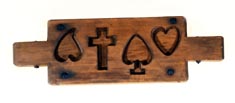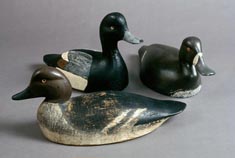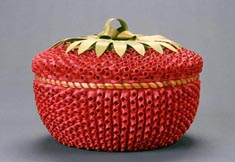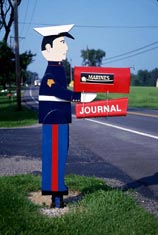What is Folk Art?
That’s a subject that’s been debated in America for a long time. In short, it’s generally agreed among scholars that interest in “American folk art”--a term coined by curators and collectors--first began in the 1920s, when artists returning from Europe after World War I began looking for what was American about American art. In addition, the Modern Art movement was underway then, with artists seeking to defy the old, formal rules of the academy and finding new ways to express themselves visually.
 The first museum
exhibitions of American folk art began in the 1930s and for the next
half century the objects collectors sought had been created in
pre-industrial America. Most had been made by artisans in rural
areas for utilitarian purposes, deemed by the art world as
“primitive” or “naive,” and to the eyes of most beholders,
as quaint and romantic. In the simple forms and primary colors of
decoys, quilts, early portraits, ship's figureheads, weathervanes, and stoneware pottery,
for instance, the artists and collectors found both charm and
inspiration. In her introduction to the exhibition catalog The
Flowering of American Folk Art (1974), Alice Winchester wrote:
"One may look for, and find, originality of concept, creativity
of design, craftsmanly use of the medium, and flashes of inspiration,
even genius. Folk art makes its appeal directly and intimately, even
to people quite uninitiated into the mysteries of art."
The first museum
exhibitions of American folk art began in the 1930s and for the next
half century the objects collectors sought had been created in
pre-industrial America. Most had been made by artisans in rural
areas for utilitarian purposes, deemed by the art world as
“primitive” or “naive,” and to the eyes of most beholders,
as quaint and romantic. In the simple forms and primary colors of
decoys, quilts, early portraits, ship's figureheads, weathervanes, and stoneware pottery,
for instance, the artists and collectors found both charm and
inspiration. In her introduction to the exhibition catalog The
Flowering of American Folk Art (1974), Alice Winchester wrote:
"One may look for, and find, originality of concept, creativity
of design, craftsmanly use of the medium, and flashes of inspiration,
even genius. Folk art makes its appeal directly and intimately, even
to people quite uninitiated into the mysteries of art."
 During the
1970s, especially after the American Bicentennial in 1976, a few
collectors and dealers were beginning to dispute the notion that folk
art production stopped a hundred years before or, at least, by the
beginning of the 20th century. At the same time, some
folklorists and anthropologists had become interested in the European
approach to scholarship, with more of an emphasis on traditional
material culture–-architecture, costume, food, crafts, and art-–and
a more holistic understanding of the culture in which it exists. They began to examine what they found as tangible examples of folk
expression. Discussions--even strong disagreements--about criteria
and value occurred between the two camps--aesthetic and ethnographic--in publications and
conferences.
During the
1970s, especially after the American Bicentennial in 1976, a few
collectors and dealers were beginning to dispute the notion that folk
art production stopped a hundred years before or, at least, by the
beginning of the 20th century. At the same time, some
folklorists and anthropologists had become interested in the European
approach to scholarship, with more of an emphasis on traditional
material culture–-architecture, costume, food, crafts, and art-–and
a more holistic understanding of the culture in which it exists. They began to examine what they found as tangible examples of folk
expression. Discussions--even strong disagreements--about criteria
and value occurred between the two camps--aesthetic and ethnographic--in publications and
conferences.
Art historians, some folk art collectors, and dealers were primarily interested in objects, usually judging them as “art” if they met the formal, accepted standards of the academy or of the marketplace. Folklorists were more interested in the process by which things were created, the biographies and histories of the people who created them, and the contexts–-ethnic, religious, occupational, regional, familial-–in which they were created and used.
 In 1975,
folklorist Barre Toelken articulated the nature of aesthetics in folk
expressions in The Dynamics of Folklore this way:
In 1975,
folklorist Barre Toelken articulated the nature of aesthetics in folk
expressions in The Dynamics of Folklore this way:
What makes folk art different from fine art is precisely that it is based on the aesthetic perception, expression, and appreciation of the community adventures of everyday life...Folk artists are likely fiercely aware of what is good and beautiful in their areas of expression, and even more aware of what their close group [families or communities] will think about it. Guided by a sense of community aesthetic, which is usually unspoken because it is functional, not intellectual...the folk artist is more likely to focus on the item being produced than on his own abilities.
Borrowing from an essay I wrote in 1982 as an introduction to the catalog for the exhibition Found in New York’s North Country: The Folk Art of a Region, with a few revisions I still say that the criteria for “folk art” are:
-
The techniques and values of the artist have been learned in an informal manner, by observation, example, or self-teaching.
- People closest to the artist have been his or her strongest and most valued supporters and critics.
- The artist has developed a flair for expression, a good eye, and a sense of creativity that is consistent with his or her shared group's aesthetic sense.
- The objects reflect the contexts for their being made or used and the values of the people who have inspired their creation.
 What we can see
in folk artists’ work when it is collected together is mute but
convincing testimony that the North Country is and has been a place
of considerable folk art production, a source for inspired artists without formal art training and without formal rules. It reflects the
many aspects of local history and folk culture of the region. It is
evidence of diverse group traditions and of a variety of orientations
that daily life has taken.
What we can see
in folk artists’ work when it is collected together is mute but
convincing testimony that the North Country is and has been a place
of considerable folk art production, a source for inspired artists without formal art training and without formal rules. It reflects the
many aspects of local history and folk culture of the region. It is
evidence of diverse group traditions and of a variety of orientations
that daily life has taken.
The skilled work of Mohawk sweetgrass basket makers and beadworkers, the simple graphics and fine stitches of Old Order Amish quilters, or a Catholic house shrine and carved wooden figures of French-Canadian influence illustrate a few of the ethnic traditions to be found in the region. Weathervanes and a Holstein cow made of recycled materials are among the evidence of the importance of agriculture over time; waterfowl decoys, fish carvings, and hooked rugs with Thousand Islands scenes speak of life along our rivers and lakes; rustic twig and bark furniture, ash splint packbaskets, and etched tree funguses reveal some of the influences of the woods.
An early decorated tavern sign, scenes of village life, political banners, and a quilt of all the historic woodsmen’s hotels in an Adirondack town, as well as the products of once-vigorous local industries like pottery and glassware, remind us of the significance of our small towns over time. And the vast array of useful and decorated objects for the home–-furniture, quilts, and rugs among them–-emphasize the large role of domestic activity in the lives of people of the region through the generations.
This website presents numerous historical and contemporary examples of folk art as we define it and some of the salient information we’ve been able to gather about each. Observed individually, the pieces can reveal good information about their maker and what inspired him or her to create them; taken together, they can speak volumes about the relationship of the artistic expressions to everyday life in the North Country over the last two centuries.
– Varick A. Chittenden










